March 2004 archives
March 1, 2004
The Amazing Adventures of CG Max
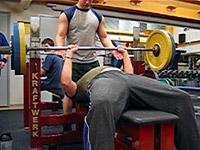 New month, new adventures. For the first time since my first wavering steps into the world of powerlifting last May, I slid my hands in close - index fingers at smooth - to find out if my close grip max is indeed in the neighborhood of my 1RM bench. After last week’s less than stellar performance on the bench, I did indeed punch up 97.5 kg/215 lbs to lockout after a near failure at 100 kg/221 lbs (first time this trick ever worked!). Reattempted 100 kg/221 lbs some five minutes later, but by now the fatigue made that attempt an embarrassment for all. This means that I will embark on the new six-week benching program with the same max weight for the wide and close-grip benches. Weirdness does happen.
New month, new adventures. For the first time since my first wavering steps into the world of powerlifting last May, I slid my hands in close - index fingers at smooth - to find out if my close grip max is indeed in the neighborhood of my 1RM bench. After last week’s less than stellar performance on the bench, I did indeed punch up 97.5 kg/215 lbs to lockout after a near failure at 100 kg/221 lbs (first time this trick ever worked!). Reattempted 100 kg/221 lbs some five minutes later, but by now the fatigue made that attempt an embarrassment for all. This means that I will embark on the new six-week benching program with the same max weight for the wide and close-grip benches. Weirdness does happen.
The several heavy attempts made this an awfully slow workout. As you can see and hear on the video clip (2.9M) there was quite a gathering at the gym around 7pm. I usually train around 3pm when the air is fresh and the music pristine. Quickly did some rows and an incline hammer curl/incline tate press superset and hit the shower content. Let this be the last time my max bench, with any grip, fails below 100 kg/221 lbs! So there.
Close-grip bench:
5 @ 40 kg/88 lbs
5 @ 50 kg/111 lbs
3 @ 60 kg/133 lbs
1 @ 70 kg/155 lbs
1 @ 80 kg/177 lbs
1 @ 90 kg/199 lbs
1 @ 95 kg/210 lbs
0 @ 100 kg/221 lbs
1 @ 97.5 kg/215 lbs
0 @ 100 kg/221 lbs
T-bar row, chest supported: 8,8,5 @ 60 kg/133 lbs, 15 @ 35 kg/77 lbs
2 supersets:
Incline hammer curl: 10,8 @ 16 kg/35 lbs
Incline tate press: 6,3 @ 16 kg/35 lbs
Total training time: 75 min
March 3, 2004
Short and sweet
The stiff-legged deadlifts I did on Friday hit my poor hamstrings with a vengeance. During the weekend they were so sore that I could not even fully extend my left knee joint. If it wouldn’t have been for the light posterior chain massage Sanna gave me, I probably would not have stopped limping by Monday as I did now. This is what happens when you get a back injury, take three months off the movement, and then go for sets of ten…
As speed squatting was ruled out by a nasty lingering soreness, the only sensible option was to hit only the abs, calves and grip. I think I am going to hit the stiffs next week as well. Hamboys, you better be prepared this time around!
By the way, I received Brent Mikesell’s Hardcore Powerlifting Video yesterday, which turned out to be a very enjoyable video. I have now amassed a small pile of powerlifting videos plus some books (most recently Ryan Kennelly’s The Kennelly Method) that keep reminding me that I should review them in order to give my Squatting Secrets review some much anticipated company. So don’t think I’ve forgotten. Just busy. The patient ones among you will be rewarded. Eventually.
Twisting ab machine: 4x12 @ 40 kg/88 lbs
Standing calf raise: 8,8,8,6 @ 140 kg/309 lbs
Captains of crush grippers: 12,5 @ I, 25 @ Trainer
Lying leg curls: 12 @ 25 kg/55 lbs (to flush some blood there, boy they were stiff!)
Total training time: 20 min
March 5, 2004
Precision work with a hint of vanilla
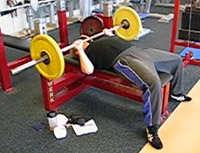 Da bench program based on da Prilepin’s table begins. I’m quite busy at the moment, but will write a script for it either of these days and also need to update the training routine page. Meanwhile, you will need to be content with this tiny look into the routine and a video clip of the JM Press (2.3M). I took this snippet so that I could see how well it stacks up to JM Blakley’s form as shown on his XTM video. Haven’t reviewed it yet, but even with this form the movement hits my lower triceps like no other.
Da bench program based on da Prilepin’s table begins. I’m quite busy at the moment, but will write a script for it either of these days and also need to update the training routine page. Meanwhile, you will need to be content with this tiny look into the routine and a video clip of the JM Press (2.3M). I took this snippet so that I could see how well it stacks up to JM Blakley’s form as shown on his XTM video. Haven’t reviewed it yet, but even with this form the movement hits my lower triceps like no other.
But back to the bench. Today called for three sets of two reps at 89% of my max, i.e. 3x2 @ 87 kg. A good opportunity to grab the tiny 0.5 kg/1.1 lbs plates! I locate three of them in the gym, then it turned out that there were some more lying around in a box in the storage room along with a bunch of 0.25 kg/0.6 lbs and 1.25 kg/2.8 lbs plates. Having done mostly singles, I had no idea whether doing doubles with 89% would be easy or too hard. Turned out to be the perfect balance; got all the three sets without too much trouble. I got really tight and lowered the bar pretty slowly on all reps, which gave me a real sense of control. Benching twice a week will probably do wonders for my technique!
If I remember, I will take a clip of the Bradford presses next time. Today was the first time I tried this movement, that at least Jim Wendler swears is one of the best movements for building a big raw bench. The barbell is pressed from the chest just slightly over the head to behind the head and then back again (this is one rep). Effectively takes much of the triceps out of the movement and puts all the stress on the shoulders. Also trains lateral movement of the shoulders in an original way. On the downside, Bradfords are a good way to take your own scalp as the bar has a tendency to travel closer and closer to your head as you get tired. This warning says it all…
you must do these carefully, it can damage your
head.
After the workout it was time to replenish my protein and maltodextrin supplies as my 1 kg/4.9 lbs box of Eiselt’s Fastway was alarmingly empty (oh dear, panic strikes!!). Bought a 1.5 kg/3.3 lbs box of Eiselt’s Protec. The bigger proportion of casein in the latter made the vanilla flavor pretty thick. After a few sips I was already beginning to long for the good old strawberry Fastway. If I can’t take it, I guess I will just have to buy another box of Fastway and mix them 50-50… of course I can take it, but you know how nice a good tasting postworkout shake is… Mental note to self, next time use a pair of scissors when opening the bag…
Should also mention that I seem to be coming down with another flu. Am raising the standard defenses, but we will have to see if they are enough.
Bench groove up:
5 @ 40 kg/88 lbs
5 @ 50 kg/111 lbs
2 @ 60 kg/133 lbs
2 @ 70 kg/155 lbs
1 @ 80 kg/177 lbs
Bench (3x2 @ 89%): 3x2 @ 87 kg/192 lbs
JM press (3x8): 8,8,5 @ 50 kg/111 lbs
Pulldown, reverse-grip (4-6x6-10): 4x6 @ 105 kg/232 lbs
Bradford press (3x12): 8,8,6 @ 40 kg/88 lbs
One-handed pressdown: 11 @ 30 kg/66 lbs
Total training time: 82 min (yo…)
March 7, 2004
Script for the Prilepin Bench program
Finally put together a script for the bench program I began on Friday.
The flu broke out. I think I will still be able to continue training as normal unless it gets worse.
March 8, 2004
Sense, sensibility and a MuscleTee
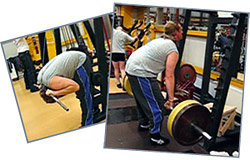 Blogs are usually about spilling your soul beans out in public. Catharsis and all that stuff. In that respect this blog is not worthy, and should probably be retired. Not that this will save it, but let me tell you that I have never trained in a tank top at a public gym before out of fear that someone will think that I’m trying to show off goods I don’t have. Let me further brief you on the fact that my social consciousness would probably have rebelled big time if I had tried taking clips a few years ago. I mean, it is kind of embarrassing filming a 130 kg/287 lbs deadlift when the guy next to you is repping with weights above 200 kg/440 lbs. If I can handle that, I can surely also train in one of the MuscleTees Sanna’s aunt graciously sent me for Christmas from the States without even having met me. I must be getting old, or then I’m just getting used to being in the spotlight whether lecturing, exposing myself on a public web site or pulling small weights in a tank top in front of a camera besides the next Ed Coan. I guess that must be why I didn’t flinch today when one guy at the gym asked, only half-jokingly, whether I am filming the next Dorian Yates training video. Go figure.
Blogs are usually about spilling your soul beans out in public. Catharsis and all that stuff. In that respect this blog is not worthy, and should probably be retired. Not that this will save it, but let me tell you that I have never trained in a tank top at a public gym before out of fear that someone will think that I’m trying to show off goods I don’t have. Let me further brief you on the fact that my social consciousness would probably have rebelled big time if I had tried taking clips a few years ago. I mean, it is kind of embarrassing filming a 130 kg/287 lbs deadlift when the guy next to you is repping with weights above 200 kg/440 lbs. If I can handle that, I can surely also train in one of the MuscleTees Sanna’s aunt graciously sent me for Christmas from the States without even having met me. I must be getting old, or then I’m just getting used to being in the spotlight whether lecturing, exposing myself on a public web site or pulling small weights in a tank top in front of a camera besides the next Ed Coan. I guess that must be why I didn’t flinch today when one guy at the gym asked, only half-jokingly, whether I am filming the next Dorian Yates training video. Go figure.
Or perhaps it all boils down to different attitudes towards clip taking. I suspect powerlifters in general understand clips in terms of technique feedback and camaraderie, while bodybuilders will naturally look at what muscle happened to land on the dude standing in front of the camera. If there is none, it is kind of embarrassing to them even if the weights are on the heavier side (real heavy and even a rhino will take notice). Guess this proves that I have succeeded in becoming a powerlifter at heart; not too hard a transformation when you have uncut arms and a stomach protecting your six-packs. Perhaps I should shave my head and get a tattoo. Perhaps not.
Now back to the regular program. Played around with some heavy deadlifting for the first time since my back injury. Tried pulling without bending the legs as much as I normally do, which turned out to look darn ugly on the video (4.1M). Went up to 130 kg/287 lbs, the same weight I had pulled back in June after one month of powerlifting training (in November I pulled 145 kg/320 lbs). I freely admit fearing that this lift might cause me to tear my ligament again, but since I have been able to do Zercher squats fairly comfortably I decided to give it a go and let it drop if things started feeling bad. Not wanting to risk an explosive start, I pulled it off the ground quite slowly as a feeler with the result that it slowed down severely at the knee. That felt dangerous enough and I was thinking I am pretty stupid still holding on to it. Pulled it all the way and felt grateful I still had my back intact. Basically, I fear that I have some scar tissue at the injury site which could cause the ligament to tear quite easily (in this regard Sanna’s massage did wonders - for the first time, the injury spot did not feel cold during the workout!). Did some easy ham work after that and finished off with standing lat pulley ab crunches.
After the workout I concluded that maxing out on singles fearing that the back will snap is neither nice nor very clever. Zercher squats are one thing, deadlifts quite another. I decided that the best thing to do is give it some more time and play it safe. As Westside has me pushing the envelope every workout, I am going to drop that for a while instead doing a 12 or 16 week moderate percentage based program. Ideally, it would have both a squat and a deadlift day, which would give me an opportunity for honing my vulgar form. Assistance work could be quite heavy for both the hams/erectors (heavy pull-throughs I can handle) and the abs. After three or four months of this I should be ready to go and in the meantime I would probably make some decent gains without putting my back health on the line. I figure I have another good twenty years in me for improving my squat and deadlift, and I don’t want to become a bench expert (I am already feeling like one). If this isn’t good sense I don’t know what is.
Deadlift:
8 @ 50 kg/111 lbs
5 @ 70 kg/155 lbs
5 @ 80 kg/177 lbs
5 @ 90 kg/199 lbs
3 @ 100 kg/221 lbs
3 @ 110 kg/243 lbs
1 @ 120 kg/265 lbs
1 @ 130 kg/287 lbs
Stiff-legged deadlift:
10 @ 50 kg/111 lbs
10 @ 70 kg/155 lbs
Lying one-legged cable curl:
5 @ 45 kg/99 lbs
10 @ 35 kg/77 lbs
Standing cable crunch, lat pulley:
6,4 @ 50 kg/111 lbs
7,6 @ 45 kg/99 lbs
17 @ 40 kg/88 lbs
Total training time: 60 min? Forgot to write it down
March 10, 2004
Sunshine!
The dark Finnish winter months are gone. Waking up at 7am it is no longer pitch black; an hour later the sun is already high enough above the cityscape to warm us with its rays. The morning temperature of -10 C/14 F climbs steadily with the sun, almost nudging zero making it pleasurably warm and injecting spring dreams into the Finnish mind. A clear blue sky… perfect weather for skiing or ice skating! This perfect winter weather will probably be with us for a few weeks and then… BOOOM! Takatalvi hits, which would be the Finnish term for the horrible awakening to a period of heavy blizzards and temperatures below -20 C/-4 F just when everybody thought spring is just around the corner… typically in April.
With season changes outside also comes season changes in the gym. For one thing most everybody seemed to be in a great mood today; the iron was light and spirits ran high! One Nigerian guy told me he woke up with this big smile on his face in the morning. On the downside, the sun is making it a lot more congested inside. Lying down on the bench, the sun also caught me straight in the eyes via the mirror. There is no question, no question at all, that overall the introspective winter mood is being replaced by the joy of being alive, which cannot but make training even more fun!
You don’t have to be a distant relative of Einstein to figure out where this post is heading. That is my cue to time out after blurting this out: close-grip benches went extremely well, I had a great groove, 80 kg/177 lbs for sets of three with a full stop felt like paper, got just the right weight for all exercises, blah blah blah… Great workout! Great life!
Close-grip bench: 5x3 @ 80 kg/177 lbs
Tate press: 3x12 @ 14 kg/31 lbs
Face pull (rope pull): 3x8 @ 40 kg/88 lbs
Side raise: 3x12 @ 12 kg/27 lbs
Standing hammer curl: 3x12 @ 14 kg/31 lbs
Total training time: 65 min
March 12, 2004
Look Ma, no box!
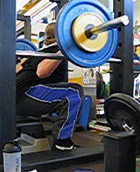 The much anticipated first go at squats powerlifting style without a box… Did several lights sets with the box first and then did my working sets trying to sit back on top of a lower step board without actually touching it. Went fairly well, but squatting this style feels pretty heavy, probably because I don’t get the benefits of a hefty forward lean. Just got to get used to the technique I guess. Looking at the video, I am quite happy about my shins that stay fairly vertical, but still need to push the abdomen out and head back more aggressively while trying to get the elbows in further. Worked up to 5 @ 70 kg/155 lbs. Might go a little heavier next time.
The much anticipated first go at squats powerlifting style without a box… Did several lights sets with the box first and then did my working sets trying to sit back on top of a lower step board without actually touching it. Went fairly well, but squatting this style feels pretty heavy, probably because I don’t get the benefits of a hefty forward lean. Just got to get used to the technique I guess. Looking at the video, I am quite happy about my shins that stay fairly vertical, but still need to push the abdomen out and head back more aggressively while trying to get the elbows in further. Worked up to 5 @ 70 kg/155 lbs. Might go a little heavier next time.
Did some good mornings too. As most readers no doubt are aware, this is the exercise were I injured my back in early December so I am going to start working back into it very slowly. Did 5 @ 50 kg/111 lbs, i.e. 50% less than my PR of 5 @ 100 kg/221 lbs, using the pins as a depth guide to make sure that I don’t go quite as low as I used to (parallel) as the last inches seem to be the ones were the injury risk and fear factor unite.
Beginning today, I am going to start packing the training clips a little more aggressively to make the file size 50% smaller. Today’s clip is a long one as the emphasis is on reviewing technique; with the old packing format it would have been 7MB, now it is only 3.7MB. I am also starting a practice of linking the image from the training clip to the video itself (the friendly click-a-pic scheme). On another note, the fact that I am currently taking a slight break from pure Westside means that the blog categories are a little bit awkward. Basically, since I don’t really have a Dynamic Effort day at the moment I am going to file all workouts under the Maximum Effort sections.
Squat:
5 @ 40 kg/88 lbs
5 @ 50 kg/111 lbs
5 @ 60 kg/133 lbs
5 @ 70 kg/155 lbs
Good morning, depth at 6 pin:
5,10,10 @ 40 kg/88 lbs
10 @ 50 kg/111 lbs
Barbell calf raise, squat stance:
15 @ 50 kg/111 lbs
10 @ 80 kg/177 lbs
10 @ 90 kg/199 lbs
10 @ 100 kg/221 lbs
Hanging leg raise (toes towards bar): 6,5,5
Total training time: 44 min
March 15, 2004
Grokking the JM Press
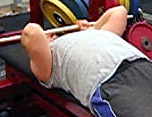 Not a very good bench performance today when taking into account that I had 10 kg/22 lbs less weight on the bar than last week. Still had a little sore pecs, so perhaps that’s were to point the shivering finger of blame. Bad bad pecs, how could you?! In the end it does not matter really; I got my 5x3 @ 78 kg/172 lbs without having to strain.
Not a very good bench performance today when taking into account that I had 10 kg/22 lbs less weight on the bar than last week. Still had a little sore pecs, so perhaps that’s were to point the shivering finger of blame. Bad bad pecs, how could you?! In the end it does not matter really; I got my 5x3 @ 78 kg/172 lbs without having to strain.
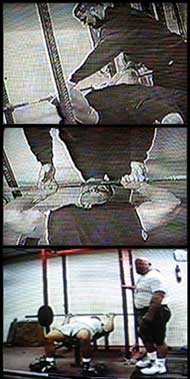 Spent quite some time working on the JM Press according to the form JM Blakley presents on his XTM bench video (first two of the video screenshots): upper arms at a 45 degree angle from the centerline of the body, bar lowered somewhere around the clavicle/neck area without dropping the elbows and with the wrists tucked away from the body, then press up. If done correctly, the bar should not be able to touch you as the forearms plus biceps meet before that.
Spent quite some time working on the JM Press according to the form JM Blakley presents on his XTM bench video (first two of the video screenshots): upper arms at a 45 degree angle from the centerline of the body, bar lowered somewhere around the clavicle/neck area without dropping the elbows and with the wrists tucked away from the body, then press up. If done correctly, the bar should not be able to touch you as the forearms plus biceps meet before that.
I started with several sets with a broomstick, then continued with the bar and finally did 2x10 @ 30 kg/66 lbs. In the beginning it felt really awkward, and the tucking of the wrists hurt a little. On the last set, I didn’t flex the wrists quite as much and that started feeling quite good.
On the video, JM emphasizes that as long as the exercise hits the lower triceps extremely hard one is doing OK, even if the form is not quite perfect. Previously, I lowered the elbows a little trying to emulate the form shown on the Westside Bench Secrets video (last screenshot - hey, that’s Louie Simmons right there).
I will need to take a closer look at my form still, but it is getting too late and I want to start recuperating under the sheets.
Today’s clip (5.3M) has all movements excluding the last set of one-handed pressdowns, i.e. precisely the movement where my triceps look good ;^)
Bench groove up:
10 @ 40 kg/88 lbs
5 @ 50 kg/111 lbs
2 @ 60 kg/133 lbs
1 @ 70 kg/155 lbs
Bench (5x3 @ 80%): 5x3 @ 78 kg/172 lbs
JM press (3x8): 2x10 @ 30 kg/66 lbs
Pulldown, reverse-grip (4-6x6-10): 4x7 @ 105 kg/232 lbs
Bradford press (3x12): 9,6 @ 40 kg/88 lbs
One-handed pressdown: 15 @ 30 kg/66 lbs
Total training time: 77 min (technique training takes time bro)
March 17, 2004
New program, sort of…
After that near max dead last week, I mentioned that I was looking for a “12 or 16 week moderate percentage based program” that would hone my lifting technique and keep me away from the max lifts so typical of regular Westside training while I make sure that my back has indeed recuperated from the injury. To get some much needed advice I again started a thread over at Westsidebar.net (as usual, this one is in Finnish).
Petteri suggested something like five weeks of tens, five weeks of sixes and five weeks of triples with the training load adjusted so that a very conservative 5 kg/11 lbs would be added to the 3RM. The load would be determined by first adding this gain to the last week (15) and then subtracting 2.5 kg/5.5 lbs from that every week. Below is his example using a current 3RM of 120 kg/265 lbs. Note that this scheme very naturally introduces a degree of load cycling; the weight remains the same at every transition from a higher rep range to a lower, i.e. the program gets easier for a couple of weeks before again becoming progressively more demanding. The total number of sets is left to the lifter’s consideration.
Triples
week 15: 125 kg/276 lbs
week 14: 122.5 kg/271 lbs
week 13: 120 kg/265 lbs
week 12: 117.5 kg/260 lbs
week 11: 115 kg/254 lbs
Sixes
week 10: 115 kg/254 lbs
week 9: 112.5 kg/249 lbs
week 8: 110 kg/243 lbs
week 7: 107.5 kg/238 lbs
week 6: 105 kg/232 lbsTens
week 5: 105 kg/232 lbs
week 4: 107.5 kg/238 lbs
week 3: 105 kg/232 lbs
week 2: 102.5 kg/227 lbs
week 1: 100 kg/221 lbs
I like this scheme for its simplicity and moderate nature. Some posters thought it was a waste of time to do more than five rep sets for powerlifting, while noting that higher reps on the deadlift tends to screw up their backs without fail. Don’t know about that, but I feel this program might not be totally ideal for technique training as the high rep range makes it harder to concentrate on good technique on every rep. I feel a 3-5 rep program that stays at least a rep short of failure would be most appropriate for me in my current condition. Will have to try something like this at some point though.
Riku wrote that he was looking for a similar moderate program, and that he was considering doing a 5x5 program over at Joe Skopec’s for his squat. I almost succumbed to the charms of this 16 week cycle that begins fairly moderately ending with 5 reps with the former max. I could have subtracted a little weight from my true max and this program would have been at a good intensity level. Yet, the idea of locking myself into a long-term moderate program does not seem all that appealing since it would not really give me any tools to adjust the intensity level up or down according to feedback from my body. Come to think of it, that is really what I need: the option to go heavy if it feels good, and the option to throttle back if needed. Bye bye, percentage programs!
To break out of paralysis due to analysis, I decided to keep it simple: do 3-5 reps a set for 2-5 sets. The aim is to slowly push up the training weights, but there will be no shame in lowering weights if needed.
This was then what I did today. Despite a nagging headache, I worked up to three sets of triples with 110 kg/243 lbs. Heavy enough, but not too heavy. Then punished the midsection with standing ab crunches, the twisting ab machine and dumbell side bends. By the end of it, the headache was gone. Quelle miracle!
Deadlift: worked up to 3x3 @ 110 kg/243 lbs
Pull-through, bent legged: 3x12 @ 90 kg/199 lbs
Standing cable crunch, lat pulley: 3 @ 50 kg/111 lbs, 3x10 @ 40 kg/88 lbs
Twisting ab machine: 2x8 @ 50 kg/111 lbs
Dumbell side bend: 10 @ 30 kg/66 lbs
Total training time: 67 min
March 19, 2004
The sixth element
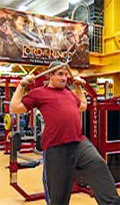 3 kg/7 lbs more on the close-grip bench than last week for the same 5 sets of 3. Went quite well, and still had the required extra rep in me. Except for on the last set that is, when the last rep started being tough. After reviewing the clips of the bench, it turned out that I had mismanaged my set count as I found clips of six sets! All in all, not too shabby then.
3 kg/7 lbs more on the close-grip bench than last week for the same 5 sets of 3. Went quite well, and still had the required extra rep in me. Except for on the last set that is, when the last rep started being tough. After reviewing the clips of the bench, it turned out that I had mismanaged my set count as I found clips of six sets! All in all, not too shabby then.
Got some more reps on the assistance work as well. If it weren’t for the extra rest added to this program, by rotating the four training days over three training sessions a week, I think working the assistance exercises this hard might be a no-no. At least for me.
The video from today (5.6M) shows all exercises, including the face pulls above. As you can see, I have really sobered up on the dumbell side raises by dropping the weight drastically from the 16 kg/35 lbs dumbells I was heaving up on the clip from 10 December 2003. I am now a wanna-be technique junkie.
Before I fade to black, I should mention that Dave Tate has another article out at T-mag entitled The Education of a Powerlifter (Part I), “a story about one man’s journey into the cult of powerlifting”.
Close-grip bench groove-up:
10 @ 40 kg/88 lbs
5 @ 50 kg/111 lbs
3 @ 70 kg/155 lbs
Close-grip bench: 6x3 @ 83 kg/183 lbs
Tate press: 3x8 @ 16 kg/35 lbs
Face pull (rope pull): 3x10 @ 40 kg/88 lbs
Side raise: 3x13 @ 12 kg/27 lbs
Standing hammer curl: 13,13,10 @ 14 kg/31 lbs
Total training time: 80 min
March 21, 2004
Seated good mornings link
Stumbled upon this clip (1.4M) of strongman Clint Darden doing Seated GMs for 5 @ 165 kg/365 lbs. Ouch!
March 22, 2004
One of those days
Second go at squats powerlifting style without a box. Thought I would go for 3x3 with something like 75 kg/166 lbs or 80 kg/177 lbs. Everything went so-so until I did 3 @ 70 kg/155 lbs, when the left side of my hip towards the back decided to stiffen up on the second rep. I’ve had things like this before; hopefully it will go away with some rest and massage. How smart is it to continue doing a third rep after feeling that something is not quite right on the second rep? Plain stupid. I’ve never been one to stop a set as long as I’m not injured, but it is high time I learn this noble art. And how smart is it doing good mornings following this? “The pain is to the side, will probably feel better after some light GMs”… Plain very darn stupid, that’s what. The fact that I stopped here without continuing with calves and abs gives a glimmer of hope for the future.
Did tape my squats and tried hard to get the elbows in instead of flaring them back. Overall, today’s clips do not really represent any improvement over those from ten days ago, if anything these sets look worse (you will just have to trust me on this, ain’t gonna upload ‘em). Simply wasn’t my kind of training day today. Give it a rant on the blog and move on. Preferably into a nice pre-warmed bed. ![]()
Squat:
3 @ 40 kg/88 lbs
3 @ 50 kg/111 lbs
3 @ 60 kg/133 lbs
3 @ 70 kg/155 lbs
Good morning, depth at 6 pin:
10 @ 30 kg/66 lbs
10 @ 40 kg/88 lbs
10 @ 50 kg/111 lbs
Total training time: something like 25 minutes or so
March 24, 2004
Give me a blue one, please
It finally happened. I forgot my training shirt at home. Tripped over to the 50% discount rack and found a blue Better Bodies tee that agreed with my constitution. Hefty discount, but still hefty price: 19 euro. Next time I think I will be forgetting my pants.
Week 3 of Patrik Nyman’s Prilepin Bench program with a target of 5 sets of 3 at 86% of max. It was a pinch, but I got them.
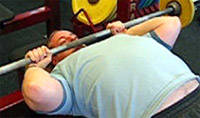 JM Presses next. This time I experimented with allowing the elbows to come down a little to make it feel less like a french press/extension movement and more like a press hybrid (video 1.4M). Also hoped this would take some of the stress off the wrists caused by tucking them forward at the bottom of the stroke. Worked well, and actually put me in a position very similar to that shown on the JM Blakley video (screenshots here). This is how I will be doing them from now on.
JM Presses next. This time I experimented with allowing the elbows to come down a little to make it feel less like a french press/extension movement and more like a press hybrid (video 1.4M). Also hoped this would take some of the stress off the wrists caused by tucking them forward at the bottom of the stroke. Worked well, and actually put me in a position very similar to that shown on the JM Blakley video (screenshots here). This is how I will be doing them from now on.
My back was still stiff, although now the pain had migrated from the left side more toward the center. Reverse-grip pulldowns proved to be too stressful in this department, so back to the faithful standby: chest-supported T-bar rows. Could also feel my back just doing Bradford presses. Enough is enough; after doing some one-handed reverse-grip pressdowns with the same weight I used for the same exercise with an overhand grip last time, I made my way over to the front desk and booked a time to the resident osteopath for tomorrow. Interesting times ahead.
Bench groove up:
10 @ 40 kg/88 lbs
5 @ 50 kg/111 lbs
3 @ 70 kg/155 lbs
Bench (5x3 @ 86%): 5x3 @ 84 kg/186 lbs
JM press (3x8): 7,8,4 @ 35 kg/77 lbs
T-bar row, chest supported: 10,10,8,6 @ 50 kg/111 lbs
Bradford press (3x12): 9,7,7 @ 40 kg/88 lbs
Reverse-grip One-handed pressdown: 6 @ 35 kg/77 lbs
Total training time: 75 min
March 25, 2004
New powerlifting journal and Tate article
To my great joy, I have seen an increase in correspondence from people who are reading my blog. The most memorable one yet was from a powerlifter from the 1970s, who told me this blog made him start training again. I am deeply honored.
In a more recent e-mail, Justin Godin informs me that he just started his own powerlifting journal. Like me back in May 2003, he is making the switch from bodybuilding oriented training to pure powerlifting and he is doing it Westside style. I for one will be very interested in reading this one and sincerely hope that it will stick around contrary to the blog by Chris McClinch that I had so much hope for (no update since December).
Finally, part II of Dave Tate’s The Education of a Powerlifter is out at T-mag.
March 27, 2004
Trigger happy bone cruncher
Went to see the osteopath as planned on Thursday for my lower back pain, my first visit to a joint mobility specialist. After stripping down to my underwear, he had me bend forward and sideways to assess mobility. Then he poked his way down my spine and concluded that I had come just in time. “Seems like we have quite a mess here”. Just what I wanted to hear. I knew I was in good hands.
He told me to get on the bench sideways with my stomach facing him and the upper leg bent. “Now fill your lungs… exhale…”. I felt a nice crunch in my lower back as he pressed his bodyweight down on my leg. “Ok, that jumped into place. Now turn around”. Within minutes he had crunched both my lower and upper back from several angles and I was feeling increasingly satisfied with having come. He told me that my lower back was not as static as he had first thought, but I had had a lock in my upper back that must have been there for quite some time. After locating some sore points in my gluteus, he gave me a brisk but hard glute and hamstring massage. “Done!”.
Standing up, I could indeed feel the difference. My shoulders felt light and I had more ease of movement in the upper back. My lower back pain had also sharply diminished. Pointing down at my lower back, he said that three of the vertebra had been out of sync restricting full movement. “You have tight gluteus” he continued, “those often cause pain to radiate to the lower back”.
At this point I was all smiles, and blurted out that I would continue taking it careful with my lower body training and work on technique. “Nah, just don’t do any twisting movements for the rest of the day”. He then assured me that my musculature was in quite good shape and that I could begin to train hard very soon. Happily paid the 35 euro and scheduled a check-up appointment for two weeks later.
The next day, the pain had reappeared, this time to the right side. Some very light soreness was also to be felt around the spine where the therapist had exerted his well-channeled therapeutic spinal violence. Deadlift day? No way, Josť! Went swimming instead, figuring that it would be an ideal low strain activity with which to push some needed blood into the area. Hitting the sack in the evening I did indeed feel better.
Waking up today, I still had some light stiffness on the right side. Halfway through a morning stroll with Sanna, it stiffened up some more. Once home, Sanna pulled out The Trigger Point Therapy Workbook to see whether there could be any of those nasty buggers involved, something that looked somewhat likely as the osteopath had already suggested that the back pain could be traceable not to the back itself but to the gluteus. For those of you unfamiliar with trigger points, here’s the general enlightening gist summarized from a chapter aptly titled “All about Trigger points”:
Travell and Simons define a trigger point as “a highly irritable localized spot of exquisite tenderness in a nodule in a palpable taut band of muscle tissue”. The first part of that definition just means that a trigger point hurts like the devil when you push on it. [..] The “nodule” in the formal definition is the trigger point itself. To your fingertips, it feels like a knot or a small lump that can range in size from a pinhead to a pea. [..] The “palpable taut band” is a semihard strand of muscle that feels like a cord or cable and is easily mistaken for a tendon. Taut means it’s tightly stretched. Palpable means you can feel it with your fingers. [..]
A trigger point is not the same thing as a muscle spasm. A spasm involves a violent contraction of the entire muscle. A trigger point is a contraction in only a small part. [..]
The defining feature of a trigger point is referred pain. [..] Back pain always has a myofascial component, no matter the official diagnosis. Although arthritis, bad disks, and displaced vertebrae come quickly to mind when your back hurts, back pain very often is nothing but referred pain from myofascial trigger points. Pain in your lower back can come from trigger points in surprising places, such as your buttocks, your stomach muscles, or even knotted-up muscles in your calves. [..] Some of the activities that create trigger points are obvious, like accidents, falls, strains and overwork. [..]
Most systems of therapeutic touch, like acupressure, shiatsu, craniosacral therapy, myofascial release, Swedish massage, and even deep tissue bodywork - despite their good uses - are also too nonspecific to guarantee success with trigger points. For dependable results, therapy needs to be applied directly to the trigger point. [..] The safest and most effective method of trigger point therapy, according to Travell and Simons, is deep stroking massage applied directly to the trigger point.
Davies, Clair (2001): The Trigger Point Therapy Workbook. New Harbinger Publications; pp. 17-33.
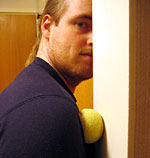 I have briefly mentioned trigger points before in the shoulder context. For much of September I had problems with my right shoulder which would get very tender after benching. Unlike other trigger points, those in the shoulder do often not refer pain, so in this case locating the source of the trouble was easy enough. It cleared up with some hard direct massage of the trouble spot. In December and January, the problem returned. Although I did not write about it in the blog, I had some fears that I might not be able to complete the benching intense Prilepin bench program if it turned out that the shoulder could not take it. After Sanna bought the above book, I learned that these problems are very easy to take care of oneself with the aid of a tennis ball, or similar, which is placed between the wall and the trigger point. Massaging the trigger point hard (pain should be roughly 7-8 on a scale from 1 to 10) in one direction for one minute several times a day once or twice a week results in instant relief and keeps shoulder pain away completely. The chance of the back problem being in the same league sounded almost too good to be true.
I have briefly mentioned trigger points before in the shoulder context. For much of September I had problems with my right shoulder which would get very tender after benching. Unlike other trigger points, those in the shoulder do often not refer pain, so in this case locating the source of the trouble was easy enough. It cleared up with some hard direct massage of the trouble spot. In December and January, the problem returned. Although I did not write about it in the blog, I had some fears that I might not be able to complete the benching intense Prilepin bench program if it turned out that the shoulder could not take it. After Sanna bought the above book, I learned that these problems are very easy to take care of oneself with the aid of a tennis ball, or similar, which is placed between the wall and the trigger point. Massaging the trigger point hard (pain should be roughly 7-8 on a scale from 1 to 10) in one direction for one minute several times a day once or twice a week results in instant relief and keeps shoulder pain away completely. The chance of the back problem being in the same league sounded almost too good to be true.
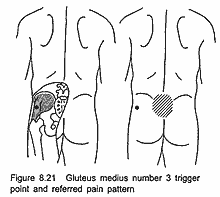
Sanna got me on her massage bench and started feeling her way through my gluteus, hamstrings and calves. The end result was that she located one tender spot on both gluteus (the left one is probably the one shown in the picture), plus one on the right calf muscle. Although it is not very easy to determine whether the gluteus ones are indeed true trigger points, or just local stiffness, due to the heavy layer of fat and muscle on top (I like to think more of the latter), initial treatment of these spots with a tennis ball against the wall have shown positive results. Invariably, most of the pain has dissipated for some time, save for the local gluteus tenderness caused by the ball. Based on her experience with clients, Sanna told me that the gluteus tend to get sore very easily from hard massage. I am taking it a little easier now with the ball to allow some of the soreness to disappear, but do hit them hard a few times per day. I will continue doing this for a while. I gather it is the only way to find out if this removes the back stiffness or not. I have also started massaging the shoulder trigger points several times a day in an effort to totally get rid of them instead of just pacifying them for the moment.
But where did this back trouble come from? From the type of pain, I can tell that this is not the ligament sprain reappearing. Besides, much of this stiffness has been off to the sides, not at the old injury spot in the middle of the lower back. The scenario that appears most likely is that this new back pain is a direct by-product of other muscles having had to protect the back injury and trying to compensate for the loss of back strength. Hence the displaced vertebrae and the tight gluteus; they could not cope with this increased burden and imbalanced musculature. In this context trigger points could also very easily develop if we are to trust Davies’s argument. In fact, he states that trigger points are often latent at first (they can be for years or forever), but then suddenly become active when straining (such as performing a heavy lift or getting into an awkward position). This would be a plausible explanation for why I suddenly started feeling pain on the left side of my lower back when squatting on Monday.
Trigger points or not, we will just have to see how things develop from here. In the meantime, I highly recommend buying the trigger point book. The fact that Dave Tate’s Elite Fitness Systems also stocks this book should testify to its importance for powerlifters. You might be pleasantly surprised to find out that you can clear up your pain with just a tennis ball.
March 29, 2004
Light weight, baby
The lightest close-grip bench day of the prilepin bench cycle did not come a day too early. Although I was benching with only 73% of my max, the triceps felt a little sluggish and slow. Hopefully, this is not an early sign of overtraining, but a testimony to how well cycled this program is. The heaviest bench session, 3x2 @ 90%, is scheduled for Friday, which should give a good indication of how things are progressing.
150th entry. Time flies.
Close-grip bench groove-up:
10 @ 40 kg/88 lbs
5 @ 50 kg/111 lbs
3 @ 70 kg/155 lbs
Close-grip bench (73%): 6x3 @ 71.5 kg/158 lbs
Tate press: 10,10,8 @ 16 kg/35 lbs
Face pull (rope pull): 3x11 @ 40 kg/88 lbs
Side raise: 14,13,13 @ 12 kg/27 lbs
Standing hammer curl: 13,12 @ 14 kg/31 lbs
Total training time: 50 min
March 31, 2004
All the money on pull-throughs
My lower back was feeling decent today. I even toyed with the idea of doing some zercher squats. Nipping this folly in the bud, I did some bent-legged pull-throughs instead. Of all the lower back/hamstring exercises I know, pull-throughs feel the most back friendly. There is none of that shearing pressure on the lower back, just a smooth balanced motion thanks to the cable.
I worked up to a new record; 10 @ 120 kg/265 lbs. Not too hard as I did not have to do any gruesome max effort exercise before it, such as squats or good mornings. The last set with the stack of the cable crossover pulley activated the pain on the left side, but up till then it was a smooth ride. Aggressively massaged the trigger points, and the pain moved aside allowing me to do some ab work. If this is indeed mostly referred pain due to trigger points, things should return to normal by tomorrow. Fingers crossed.
Pull-through, bent legged:
15 @ 40 kg/88 lbs
10 @ 60 kg/133 lbs
10 @ 80 kg/177 lbs
10 @ 90 kg/199 lbs
10 @ 100 kg/221 lbs
10 @ 110 kg/243 lbs
10 @ 120 kg/265 lbs
Ball crunch:
2x15
15 @ 5 kg/11 lbs
8 @ 10 kg/22 lbs
Twisting ab machine:
15 @ 30 kg/66 lbs
2x15 @ 40 kg/88 lbs
Total training time: 53 min
Some highly-valued feedback
Yesterday I got a back pain companion in Vincent Scelfo, who e-mailed me with the unfortunate news that he too had sustained a soft tissue injury doing good mornings. Vince is an old hand in powerlifting, having back in 1978 set New Jersey state records in the 123 pound/56 kg class, with a 440 lbs/199 kg squat, a 445 lbs/201 kg deadlift and a 1085 lbs/491 kg total. Of course, these lifts were achieved without the dubious benefits of today’s highly developed equipment. After a long layoff, he is now back re-building his strength using Westside methods.
Vince is in quite good hands with his unfortunate injury, i.e. his own, as it turns out he is a practicing chiropractic. He graciously agreed to let me post an excerpt from our correspondence, which I think adds some much needed perspective on my recent entry on trigger points.
I have been a chiropractor for over 22 years. Over the years I continually formulated my own thoughts and opinions, some of which may be totally opposite of what is taught to the general chiriopractor. This is one reason
why I became an upper cervical specialist.I have read the accounts of your injuries and I would say that you are fairly close to what I believe.
From a philosophical viewpoint, chiropractic talks about the subluxation (misaligned vertebra that produces pressure on a nerve). The result of which can be pain or illness. I do hold to this basic premise of our profession.
Where I have a problem is when things occur like a back injury. You lift something that’s too heavy. You injure the soft tissue (muscles, ligaments, joints, discs). Inflammation occurs in the tissue and you get PAIN!
The chiropractor says, “Here’s your problem, you have a bone out of place.” He adjusts you and you get some relief. The wonders of chiropractic! But now you have to keep going back 20 or 30 times to “fix” it.
The question I began asking myself was, did the bone out of place cause the
problem or was the muscle injury the reason the bone is now out of place?
There is a tremendous difference.This is where I began changing my thought about the whole mechanism of injury in relation to the chiropractic principle. It only makes sense (at least to me) that if you injure the muscle, when the muscle becomes spastic the bone is going to move and be out of position. Unfortunately, these problems are seen as “bone” problems and not soft tissue injuries which require healing.
This is why I don’t work on low backs. Instead, if you can balance the framework which is controlled by the nerve centers in the upper spinal cord, that will balance the structure. This allows the muscles to come back to normal tone and heal. I don’t have to keep “racking” a bone in place day in and day out. In the injury situation, the bone out of place is the EFFECT, not the cause. It has shifted because of injury to the soft tissue or joint. When the soft tissue heals, the bone will go back to its normal position.
This is where, in my opinion, chiropractors make a grave mistake. They adjust the bone. But it never stays in place. So you keep going back over and over.
Get the system balanced and give it time to heal.
Disc problems require long time to heal. Symptoms can be extremely painful. Joints also. Ligaments are not elastic and when injured may not return to full strength as they heal up with scar tissue. Muscle strains heal up pretty readily.But the body does heal. Some things quicker than others and depending on how much we aggravate the injury. Some people won’t stop working for 3 or 4 days to let things start healing.
[…]
In 1978, in my 2nd quarter of chiropractic school, I blew a disc while
deadlifting in a competition. It took me 8 weeks to recover. No surgery.
Just chiropractic. I came back just as strong and the following year I set
personal and state records, etc. at 123. So I know first hand about back
injuries. I’ve had my share of them. That’s one of the reasons I stayed out
of it for so long.
Vince’s mail is a good foundation for reflection on the inherent injury risk in powerlifting. There is no denying that powerlifting is a high-risk activity and injuries do happen. Some would go as far as saying that they are part and parcel of the sport, with some critics readily proclaiming that “powerlifting will only destroy your body for life”. After spending nearly a year reading various powerlifting message boards and articles, my impression is that people come back from the overwhelming majority of injuries and become stronger than ever provided they take their rehabilitation seriously. As Vince indicates, the body knows how to heal itself as long as you give it what it needs. At the extreme end, even the most dreaded disc problems, as evidenced by Stuart McGill’s must-have work in the field Low Back Disorders, can be totally healed if treated correctly (this usually does not imply surgery). Luckily, most powerlifting injuries tend to be much more benign than this, often the result of not giving enough attention to the wear and tear that comes with heavy lifting.
The challenge of powerlifting is to learn to deal with the injury risk and accept it without fearing it. The fact of the matter is that you are not very likely to cripple yourself powerlifting, but you can reasonably expect to at least get some joint ache and possibly strain a muscle or two. It does not have to get much worse than this if you become a total technique freak (videotaping helps), listen to your body (don’t do the next set if you have a gut feeling you shouldn’t) and give your minor aches time to heal before they turn chronic. Making a point of doing heavy lifts in the safety of a power rack is also not a bad idea. Turning the issue upside down, powerlifting is liable to teach you a lot about your own body and its limitations if you can stay humble and retain some semblance of a beginner’s mind. In the final analysis, I think this is actually the real challenge of powerlifting. It is too easy to be impatient, it is too easy to go too heavy too soon lured by the prospect of a new personal record, it is too easy to blindly follow the advice of others without thinking about how it suits oneself, it is too easy to… I know, I tend to do it too, but I do try to inject the occasional dose of sense and sensibility into my training. Quoting Vince, injuries due help make the point, but it’s really not the route I’d like to go to make my points.